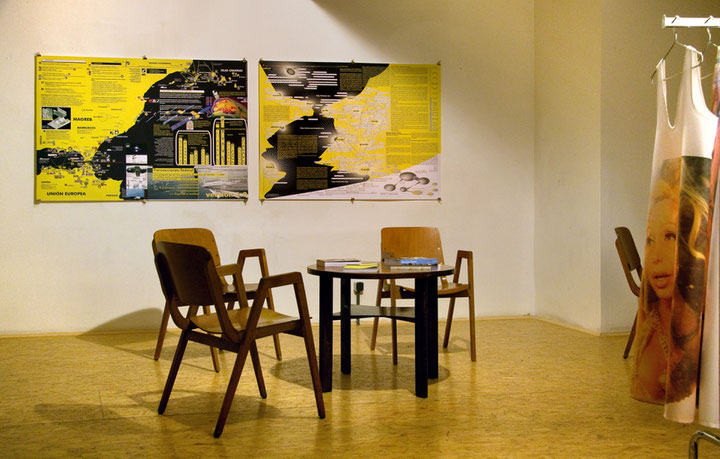Issue 1/2009 - Net section
Topographies of a networked world order
The »Networked Cultures« project in Open Space, Vienna
So close you could almost reach out your hand and grasp it: Africa and Europe on a clear day separated by the Straits of Gibraltar, with the view from the Spanish mainland looking south and vice-versa. Ceuta and Tanger are only 15 kilometres away from Tarifa, yet nevertheless the cities facing each other on the African and European Mediterranean coast are worlds apart. This territory is defined by surveillance systems, illegal border crossings and conflicts between nation-states along the external borders of the European Union, all making it difficult for migrants to cross this short distance unnoticed and, above all, in safety.
The Straits of Gibraltar is just one of the countless examples of the kind of intersection between globalisation, crisis zones, migratory flows and a thoroughly militarised border region that is coming into being in and around Europe. The social discontinuities associated with this are the starting point for a project entitled »Cartography of the Straits of Gibraltar« (2004), which was presented in autumn 2008 at the »Networked Cultures« exhibition in Vienna’s Open Space1. The development of strategic and tactical maps takes centre-stage for the artists’ collective centred on Hackitecktura.net2. The architects, programmers and Internet activists devise alternative ways of looking at the border area in south-western Europe and, with assistance from the media network Indymedia Estrecho3, draw up maps of »imperial« and »multitudinal« flows. »The borders«, to cite Pablo de Soto, one of the founders of the collective, in an interview4, »really became thoroughly militarised in 2002 through implementation of the SIVE surveillance system«. SIVE, which includes radar, infra-red and video cameras, detects migrants along the Andalusian coast who have opted to travel by water in fleeing from Africa to Europe and stigmatises them as »intruders«. A kind of invisible controlled space was called into being here by the authorities through the establishment of checkpoints.
In conjunction with Ursula Biemann’s video cartography »Sahara Chronicle« (2006–2007) and Judith Augustinovic’s installation »Skinship N°1 – Hautnah« (2008), this mapping by the Spanish media activists is part of the research project »Networked Cultures«5 initiated by Peter Mörtenböck and Helge Mooshammer. Since 2005, working with a platform based at Goldsmiths’ College in London, these two scholars of architectural theory have been probing the potential of translocal networked practices of space through interviews, exhibitions, books, films and presentations. These include such diverse modes of expression as cartography, architecture, videos, installations and collaborative artistic action. The content concentrates on cultural cohabitation and communication in the form of networks, which have changed the way our world is organised, just as they have altered how space is produced. The common denominator in all the projects examined by »Networked Cultures« is a concept of space that serves as a paradigm and develops both thematically and formally through »parallel worlds, mobility, nomadic communities, digital worlds and other alternative geographies«. In their description of the project, Mörtenböck and Mooshammer characterise their own sphere of action as »discipline-free« practices within art and architecture created over the last few years. »The arena that opens up through this process«, to cite the two researchers working in the fields of »Visual Culture« and »Relational Architecture« at Vienna’s Technical University »highlights an investigation of areas of conflict running right across Europe.«
Parallel to the exhibition in Open Space, the book »Networked Cultures: Parallel Architectures and the Politics of Space«, published by NAi Publishers, was presented at the Architekturzentrum Wien. In this work, theoretical essays, interviews and a film on the overarching topics of »Networked Creativity«, »Contested Spaces«, »Trading Places« and »Parallel Worlds« offer a glimpse of the overall look of the research platform, which is arranged in network style. The book little by little opens up access to the topography of a world order defined primarily by movements of population groups, budding social systems, the creations of auto-authorised structures – and thus also by »counter-spaces«. In »Networked Cultures«, Mörtenböck and Mooshammer generate a space from within a loose network, working through its theoretical aspects using discursive methods and in the process rendering the space legible: spatially comprehensible, so close you could reach out and grasp it, but with your mind this time.
Translated by Helen Ferguson
1 http://www.openspace-zkp.org
2 http://mcs.hackitectura.net
3 http://estrecho.indymedia.org
4 The interview with Pablo de Soto is printed in: Peter Mörtenböck/Helge Mooshammer (eds.), Networked Cultures: Parallel Architectures and the Politics of Space. Rotterdam 2008.
5 http://www.networkedcultures.org
